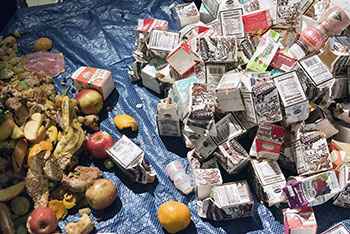 Education
Education
Education is an important component in training youth to care for the planet. Our goal is to bring issues to the forefront so students can discover their own passion for the environment and share their knowledge and enthusiasm with others.
We all have a responsibility to educate youth about the community and world around them so that they are informed with facts and key issues. The awareness they gain motivates them to become responsible, involved community and global citizens. Clark County Green Schools has many educational experiences to help students gain this awareness, empower them to make change in their community, and practice Next Generation Science Standards and Common Core Literacy and Math standards skills.
Please contact us to schedule your lesson/activity at least 3–4 weeks in advance of when you would like the lesson to occur. It is highly recommended that you have several different date/time options for your in-class lesson in mind before you contact us to schedule the lesson.
Clark County Green Schools offers the following lessons, activities, field trips, and assemblies:
Grades 2–6*
Grades 7–11*
Compost and Soil Chemistry — coming soon!
West Van Materials Recovery Facility Tour — any grades
*Grade levels listed indicate the grades for which these lessons/activities are most appropriate and have been designed to align with Next Generation Science Standards and Common Core standards for those grade levels. Please contact us if you are interested in a lesson/activity for a grade other than the one listed for that lesson.
Other environment and sustainability lesson plans and resources:
NAAEE (North American Association for Environmental Education)
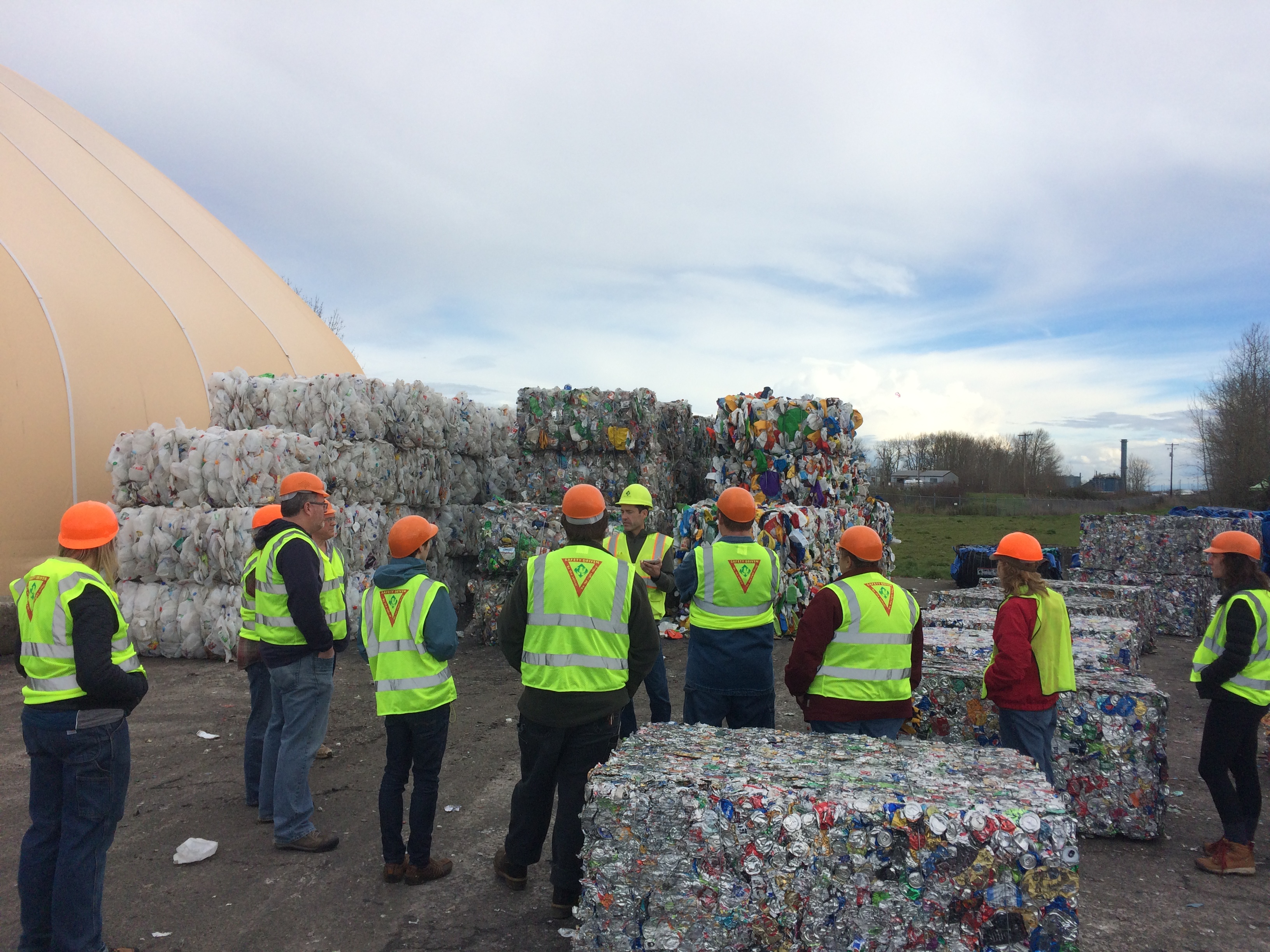
West Van Materials Recovery Facility Tour (any grades*)
Format: field trip
Length: approx. 60 minutes (plus 30 minutes for optional Tidewater bus-tour)
Requirements: *all students must be at least 8 years of age; Waste Story and Relay or Journey of Waste and Sort to follow within two weeks of tour
Topics/subjects: waste reduction, waste processing system, "why" and "how" of local recycling, solid waste careers
Recommended companion lessons: Waste Story and Relay, Journey of Waste and Sort, Waste Audit, Compost and Decomposers, Compost and Soil Chemistry, Plastics in the Water
Summary: When we put our garbage and recycling at the curb, it seems to just go "away"; come and see where it actually goes! Take your class or Green Team on a tour of our county's massive transfer station and learn how garbage and recyclables begin to be processed and shipped. On thi outdoor tour, you'll walk through Columbia Resource Company's West "Van" (Vancouver) Materials Recovery Center on NW Old Lower River Road. See the bales of each commodity that result after the towering piles of mixed recycling are sorted. It's an eye-opening experience - garbage piled high, a huge trash compactor, a mound of glass and the areas where hazardous waste, tires, electronics, appliances, and more are collected for transport and disposal. Following the West Van tour, a tour of Tidewater, the company that barges our garbage upriver to the landfill, may be available for students traveling via school bus; students stay on the school bus as it is routed through the site. See tugboats, watch a garbage container get loaded onto a barge, and learn what it takes to transport waste by water. Clark County Green Schools pays for transportation.
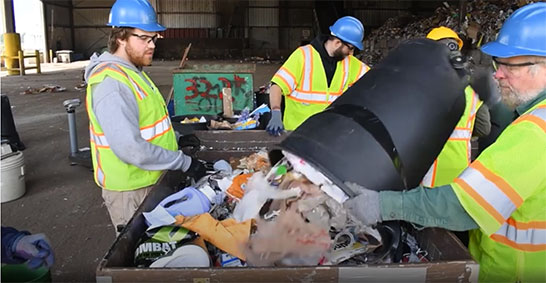
Google Earth Transfer Station Tour (any grades*)
Format: Virtual tour
Length: approx. 60 minutes
Requirements: Access to internet connection and YouTube
Topics/subjects: waste processing system
Recommended companion lessons: Clark County Green Schools Virtual Learning Center
Summary: The Clark County Green Schools team has been working hard over the last several months to deliver interesting, high-quality educational materials for students throughout Clark County. We have created a few virtual tours on Google Earth of the West Vancouver Materials Recovery Station and another comprehensive tour that shows where waste goes once it leaves the transfer station. The journey it takes might surprise you! Each tour is narrated and includes videos and quizzes. Students can navigate through all the stops on the tour and learn a bit more about how garbage, recyclables, food and yard waste and hazardous household waste is handled.
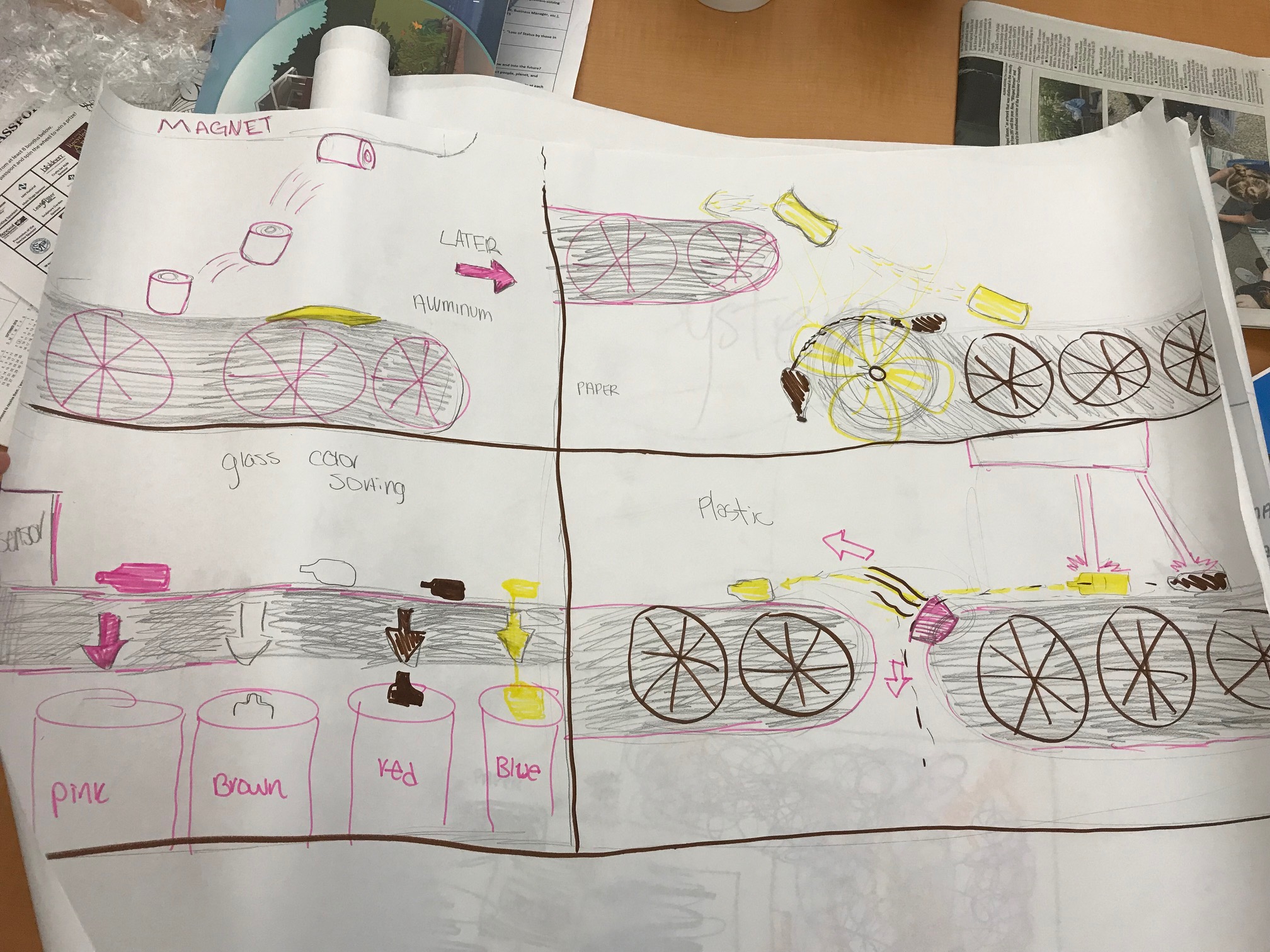
Sort System Design (Gr. 7–11)
Format: engineering challenge, group work
Length: 40–45 minutes
Requirements: Journey of Waste and Sort or West Van Tour must be done prior to this activity!
Topics/subjects: solid waste economics, natural resources, waste reduction, waste processing, real-world engineering applications
Recommended companion lessons: Journey of Waste and Sort, West Van Tour, Natural Resources
Summary: The sort system design challenge not only engages students in an activity which practices skills like problem solving, engineering practices, and collaboration, but it also helps students understand the challengers to our waste management systems and the importance of waste reduction and proper recycling. This lesson also engages students in real-world scenarios and highlights STEM careers related to solid waste management. By designing changes to the current recycle sort system in Clark County, while considering constraints to cost, time, available technology, etc., students will appreciate the resource use involved in the recycling process, and the difficulties in maximizing the resource re-capture rate via recycling. The importance of everyone in the community doing their part to recycle right will be emphasized, as well as recycling's place at the bottom of the waste-reduction hierarchy ("reduce, reuse, recycle").
Plastics in the Water (Gr. 6–8)
Format: presentation and activity
Length: 45 minutes
Requirements: space for tubs or buckets
Topics/subjects: Environmental impacts of waste, density, scope of pollution
Recommended companion lessons: Waste Audit, West Van Tour
Summary: What happens when plastics enter the ocean? Students find out by exploring the densities of different plastics. They then investigate feeding strategies and locations (surface, pelagic, and benthic) of various ocean animals and predict how plastics will affect marine food webs. The activity ends with students brainstorming actions to reduce the amount of plastics that end up as waste. Thank you to Monterey Bay Aquarium for sharing this lesson with us!

Natural Resources (Gr. 7–11)
Format: presentation, team game
Length: 45–60 minutes
Requirements: none
Topics/subjects: natural resources, conservation, importance of waste reduction and reuse/recycling, collaboration
Recommended companion lessons: Journey of Waste and Sort, Waste Audit
Summary: Students will examine the environmental consequences of consumer choice. The class will discuss the natural resources used in creating, packaging, and shipping items, and how "reducing" and "reusing" can preserve resources and reduce environmental impacts. Students will understand the variety and amount of resources required when they buy new goods and learn to recognize the environmental and social benefits of reuse and borrowing. Students will also more deeply connect with the concept of finite resources and the current impact of our consumer society on such resources. This lesson includes playing a game from Puget Sound Energy and Thurston County (WA).
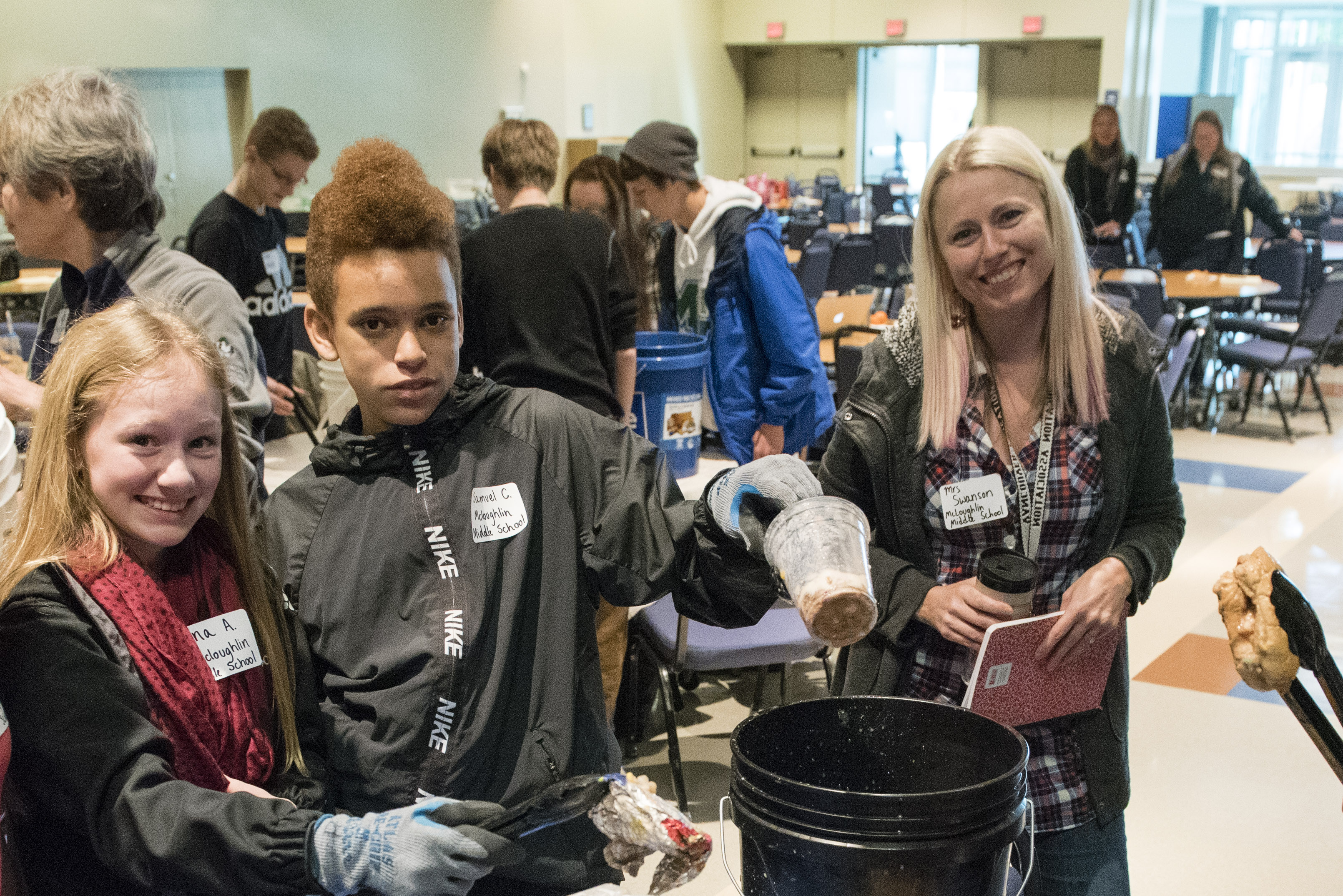
Waste Audit (Gr. 7–11)
Format: project-based learning
Length: 30–40 minutes for presentation/overview, 30-120 minutes for audit
Requirements: Journey of Waste and Sort before audit, collection of school's waste generated in one day, plan for action-project, preliminary and final audits
Topics/subjects: waste reduction; social behavior change; data collection, analysis, and application; civic-action projects
Recommended companion lessons: Journey of Waste and Sort (required), West Van Tour
Summary: The production of waste has enormous impacts on environments, economies, and societies throughout the world. Each of us has a responsibility to understand the impacts of the waste we produce, how much we produce, and how we can make choices to reduce waste and protect natural and human resources. Through the waste audit presentation and project, students will gain an appreciation for the permanence of waste and its impacts on the environment and societies. Students will recognize the enormity of how much waste we produce and thus the enormity of its impacts, gain insight into how much waste their school generates, and feel empowered to make choices to reduce waste and encourage peers to do the same. Waste audits involve sorting through the waste produced by the school in one day, and collecting data about the amounts and types of waste (garbage, recycling, compost) generated, and using that data to create a plan for improving waste reduction and disposal at the school, often through student-led campaigns.
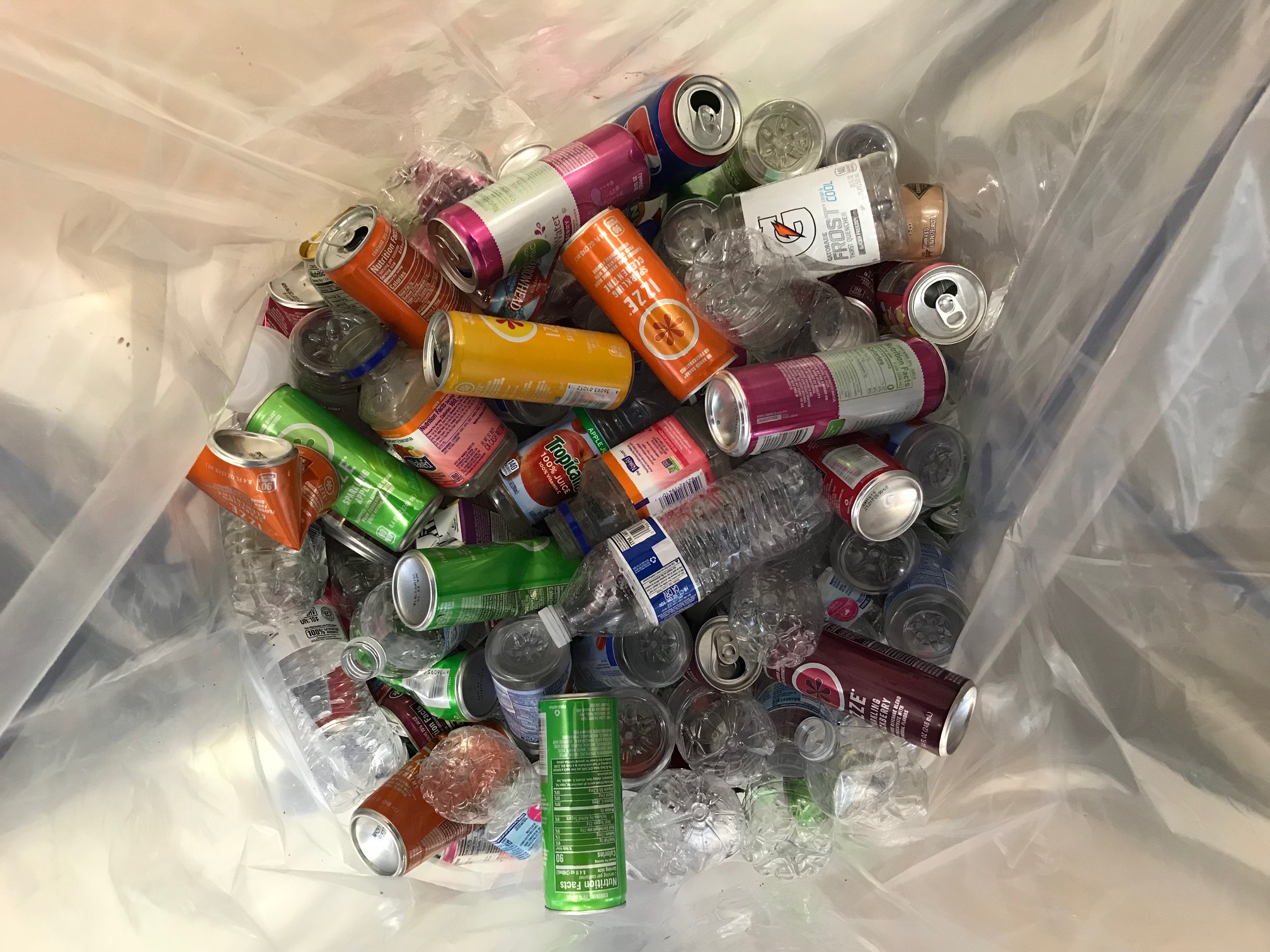
Journey of Waste and Sort (Gr. 7–11)
Format: presentation and activity
Length: 60–75 minutes
Requirements: none
Topics/subjects: “Reduce, Reuse, Recycle”, environmental impacts of waste, scope of waste production
Recommended companion lessons: Waste Audit, Natural Resources, Plastics in the Water, West Van Tour
Summary: Students will gain deeper understanding of the impacts of waste on our environment before, during, and after disposal. When we dispose of recyclables, the system used locally for sorting the recyclables dictates which items can be recycled. Students will gain understanding of the massive amounts of fuel, electricity, people-power, and time required for proper waste disposal including: landfilling of garbage; planning, structuring, and maintenance of a sort system for recyclables; and commercial composting. Students will also learn about the impacts of improper recycling on the safety of solid waste workers. They will feel empowered to make choices to mitigate the problems associated with waste generation and disposal. This lesson includes an interactive presentation, video of recyclables sorting from West Van Materials Recover Facility, and an activity to practice correct sorting of waste.
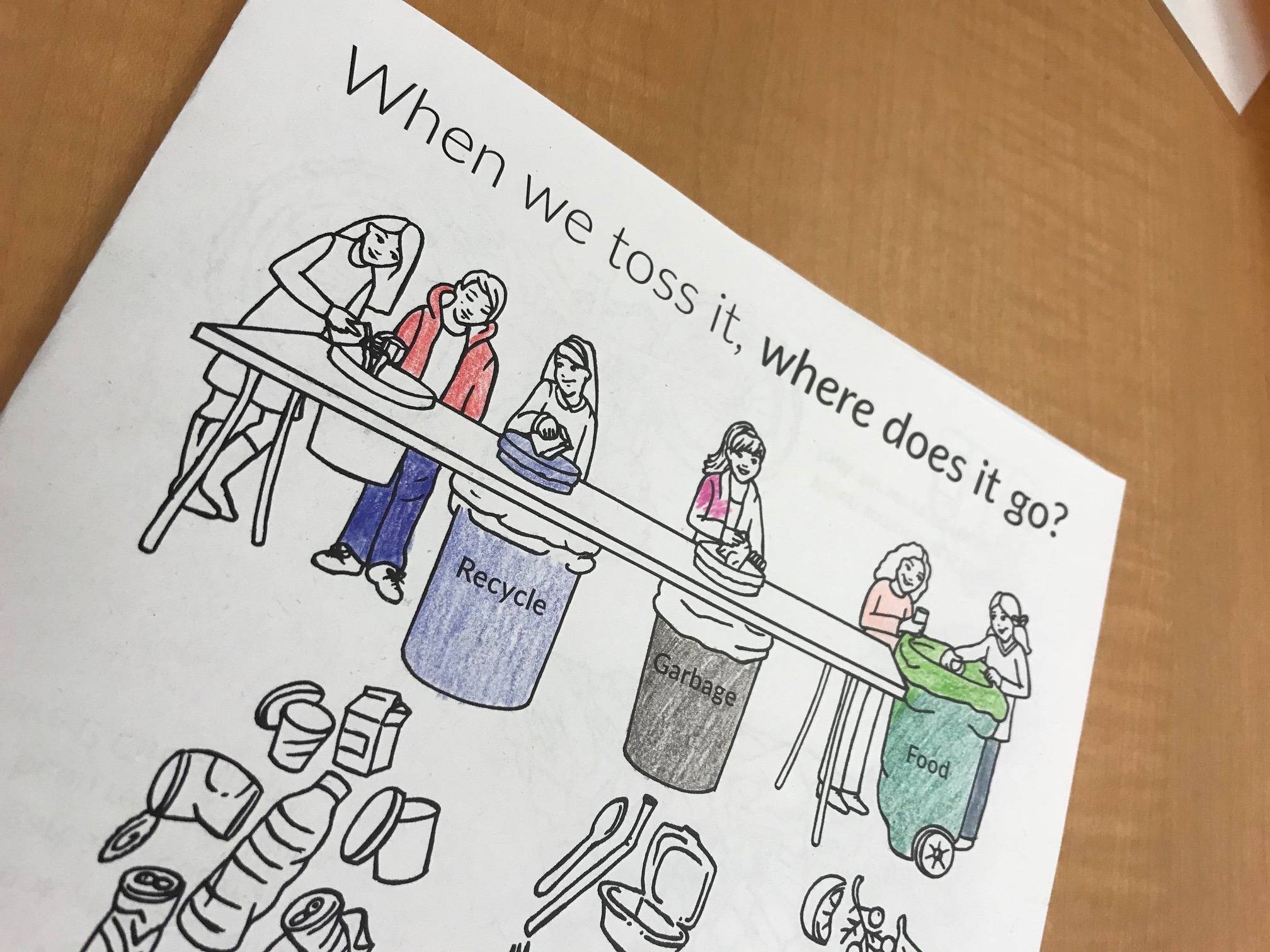
Green Schools Coloring Book
Format: independent activity, craft
Topics/subjects: recycling, composting, cafeteria waste sorting
Recommended companion lessons: this activity is a good post-lesson review for Waste Story, Compost and Decomposers, and Waste Audit; a good introduction to cafeteria sorting for new students or a review for returning students
Summary: This coloring and activity book is a great way for younger students to summarize the main ideas of what they’ve learned about recycling, composting, and how to correctly sort their waste in the cafeteria (for schools that have a Clark County Green Schools-provided sort table, especially). You can download and print the coloring book using the buttons below; if you have a lesson or activity scheduled with us, you can request that we bring coloring books to leave with you.
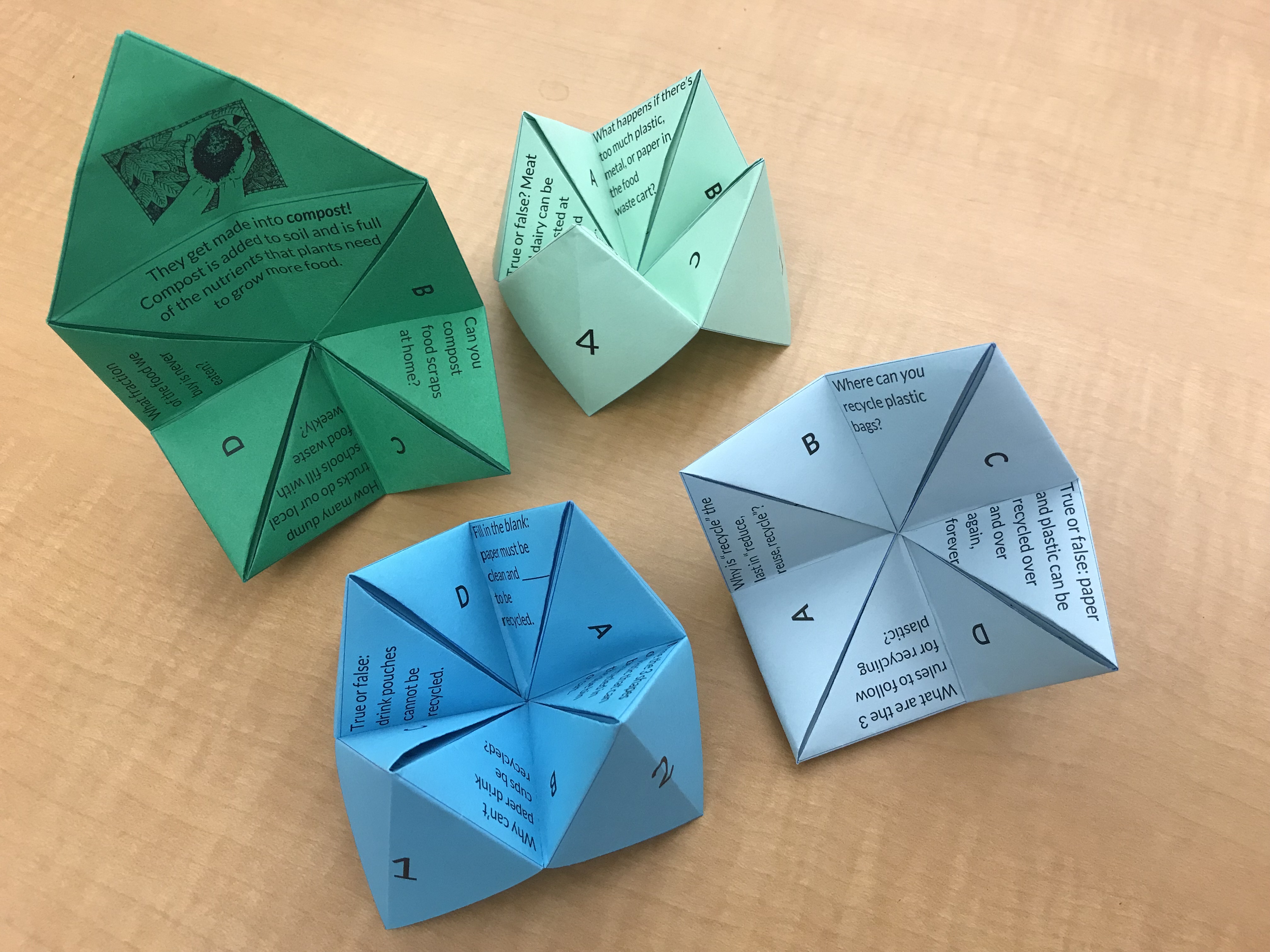
“Fortune Tellers”
Format: independent activity, craft
Topics/subjects: “why” and “how” of recycling and composting at school, review
Recommended companion lessons: this activity is a good post-lesson review for Waste Story, Compost and Decomposers, and the Waste Audit
Summary: “Fortune tellers”, “cootie-catchers”; whatever they're called, these interactive pieces of origami seem to be a timeless mainstay fo the schoolyard—so why not make them educational? There are two sets of fortune tellers, one for composting and one for recycling. Each set has two different fortune tellers, so students can get in pairs and use the fortune tellers to quiz each other. Print them out, preferably on green paper for the compost fortune tellers and blue for the recycling fortune tellers.
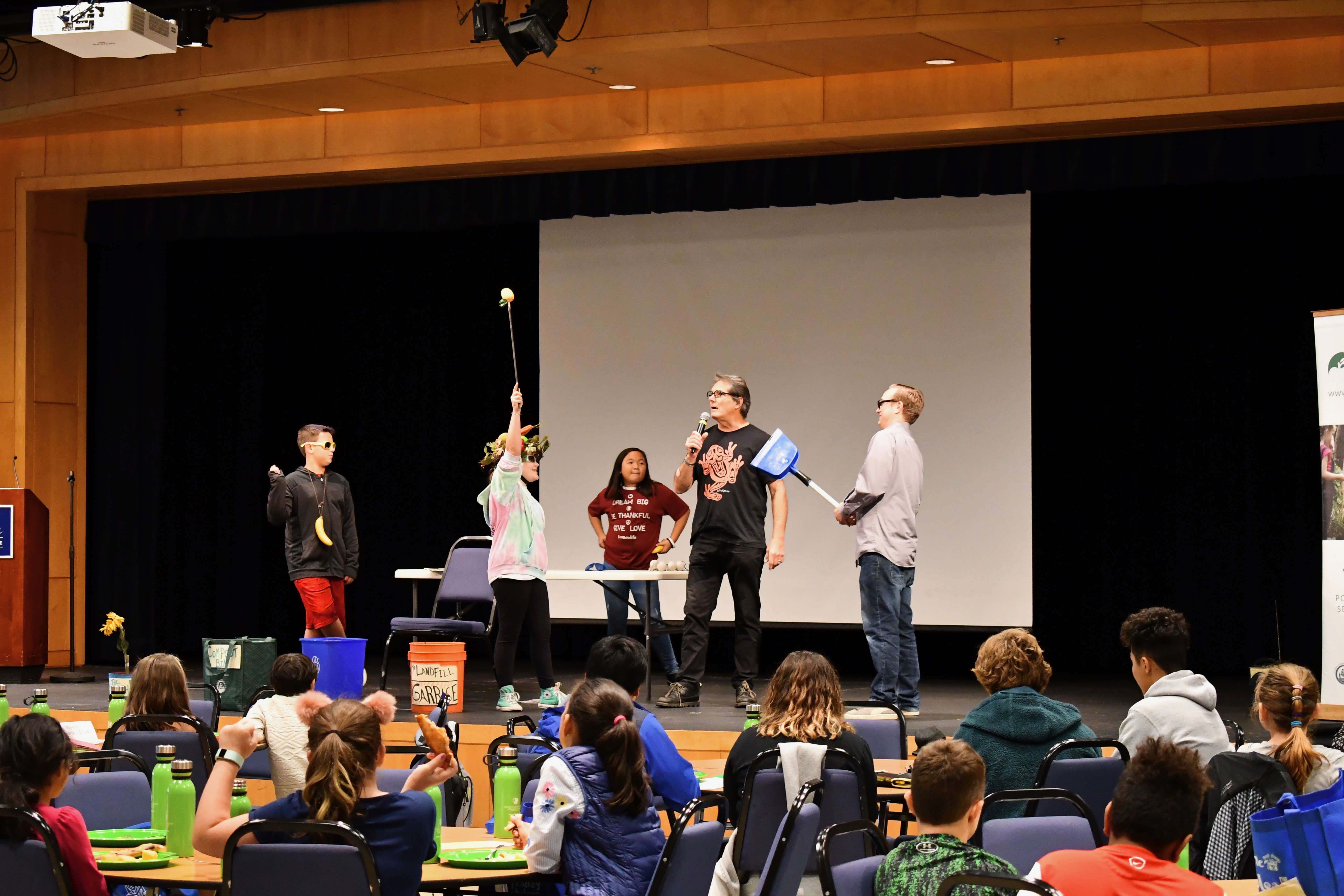
Will Hornyak, storyteller
Length: 30–40 minutes
Requirements: none; schools beginning food waste collection must have a support system plan that may include student monitors, classroom education, a Green Team, etc.
Summary: Will Hornyak is a gifted storyteller who has crafted waste reduction and sustainability assemblies for Clark County Green Schools. as part of your school's targeted efforts towards waste reduction, we will bring Will to you school at no charge. Will generally does two assemblies for an elementary school, with one for grades K–2 and another for grades 3–5, back to back.
"The students found him to be very entertaining and he was able to keep the attention of both groups for each session. Will did a great job involving the students and teachers in multiple activities and made the learning fun. His style of teaching really encouraged participation and reinforced the green concepts. I have no doubt that the students learned a lot about how to take good care of our environment." — Carmella Bender, Endeavor Elementary
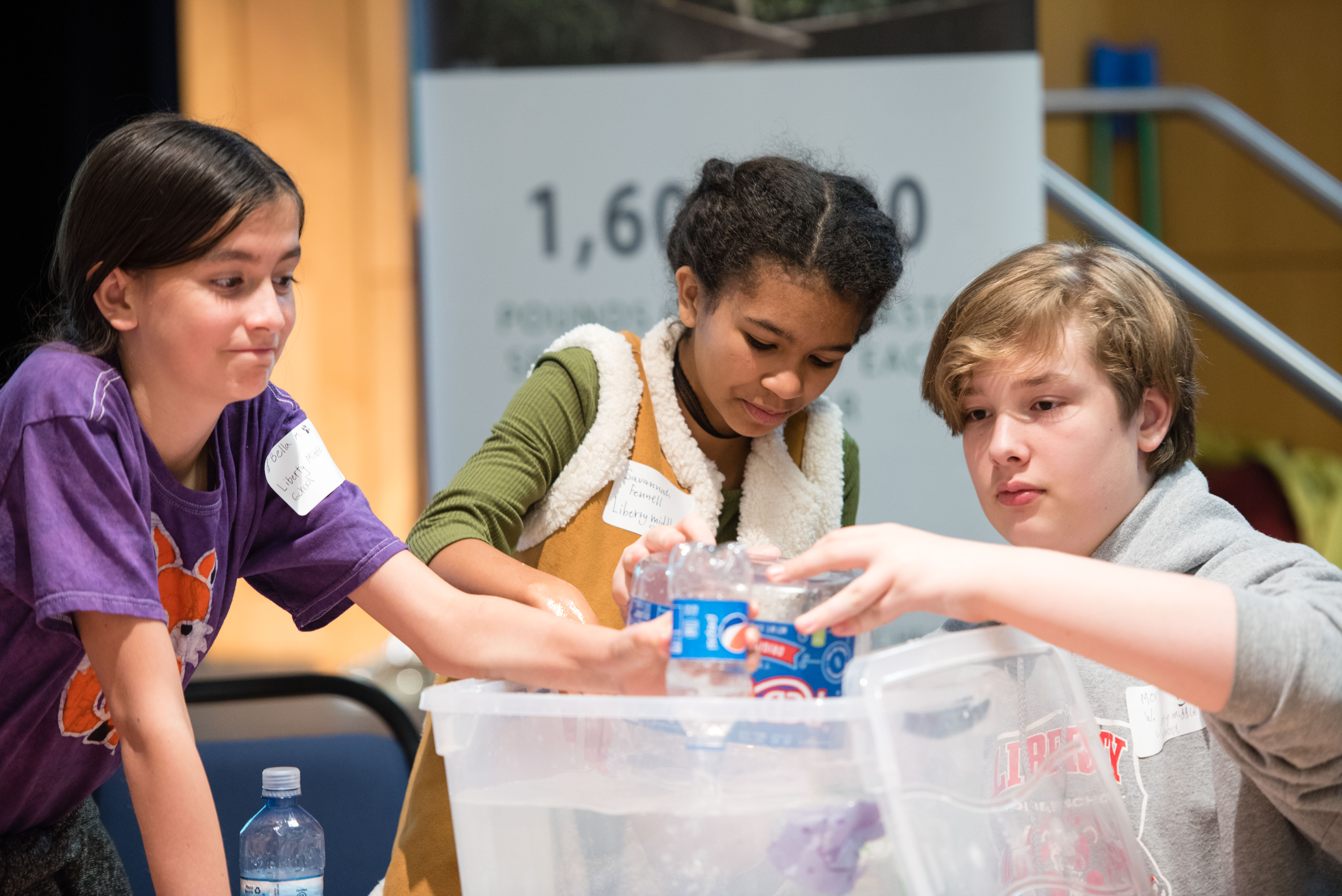
Plastics in the Water (Gr. 6–8)
Format: presentation and activity
Length: 45 minutes
Requirements: space for tubs or buckets
Topics/subjects: Environmental impacts of waste, density, scope of pollution
Recommended companion lessons: Waste Audit, West Van Tour
Summary: What happens when plastics enter the ocean? Students find out by exploring the densities of different plastics. They then investigate feeding strategies and locations (surface, pelagic, and benthic) of various ocean animals and predict how plastics will affect marine food webs. The activity ends with students brainstorming actions to reduce the amount of plastics that end up as waste. Thank you to Monterey Bay Aquarium for sharing this lesson with us!

Natural Resources (Gr. 4–6)
Format: interactive presentation, modeling, teamwork
Length: 40–50 minutes
Requirements: none
Topics/subjects: natural resources, renewable/nonrenewable, conservation, waste reduction, “Reduce, Reuse, Recycle”, resource management
Recommended companion lessons: Waste Story, Waste Audit, Compost and Decomposers
Summary: the Earth gives us everything we need—everything we use for shelter, food, and clothing comes from the Earth’s natural resources. Humans’ use and harvest of natural resources has consequences for ecosystems and our human communities. When we throw items “away” to be sent to the landfill, those natural resources are lost to the ecosystem, and to humans, forever. Students will learn that the Earth doesn’t have an unlimited supply of these resources, so we need to wisely manage our use of resources to ensure that we don’t run out of what we need to survive and thrive. This means making individual choices and working collaboratively with others to conserve and protect natural resources. Students will: discuss similarities and differences between renewable and nonrenewable resources; work collaboratively to map the natural resources used to make goods, like clothing; simulate resource extraction and its impacts on ecosystems via modeling dough; manipulate a model of the Earth and landfills; and work together to identify a source of waste and brainstorm actions they can take to reduce their impact.

Natural Resources (Gr. 2–3)
Format: interactive presentation, modeling, group work
Length: 40–50 minutes
Requirements: none
Topics/subjects: natural resources, renewable/nonrenewable, conservation, waste reduction, "Reduce, Reuse, Recycle", resource management
Recommended companion lessons: Waste Story, Waste Audit, Compost and Decomposers
Summary: The Earth gives us everything we need—everything we use for shelter, food, and clothing comes from the Earth’s natural resources. Humans’ use and harvesting of natural resources has consequences for ecosystems and our human communities. When we throw items “away” to be sent to the landfill, those natural resources are lost to the ecosystem, and to humans, forever. Students will learn that the Earth doesn’t have an unlimited supply of these resources, so we need to wisely manage our use of resources to ensure that we don’t run out of what we need to survive and thrive. This means making individual choices and working collaboratively with others to protect natural resources. Students will: discuss similarities and differences between renewable and nonrenewable resources; work collaboratively to map the natural resources used to make goods like clothing; simulate resource extraction and its impacts on the ecosystems using model dough; and assist with the manipulation of a model of the Earth and landfills.
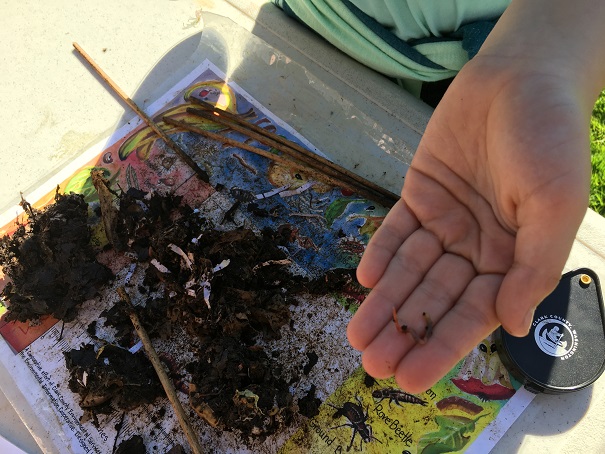
Compost and Decomposers (Gr. 4–6)
Format: interactive presentation, decomposer exploration and identification, modeling and mapping activities
Length: 20–40 minutes
Requirements: none
Topics/subjects: life cycles, relationships between organisms in an ecosystem, environmental stewardship, food production, biology, human impact on ecosystems
Recommended companion lessons: Waste Story, Natural Resources
Summary: Soil is a valuable natural resource that we depend on to produce food, keep our air and water clean, and support ecosystems all over the world. While human populations increase, soil availability and health is decreasing. Composting helps to replenish soil that may have eroded, and returns nutrients to the soil. Students will learn the value of composting and how it benefits our ecosystems and food systems: composting ensures the soil contains the nutrients needed to grow new plants and food. Students will understand how they can play a role in stewardship of the soil through composting. Students will: use their hands to model the portion of the Earth that is made of crop-producing soils; manipulate a model of the nutrient cycle; model plant uptake of nutrients; participate in a model worm dissection; and use observations of compost samples to make and support claims about the nutrient content of the compost.
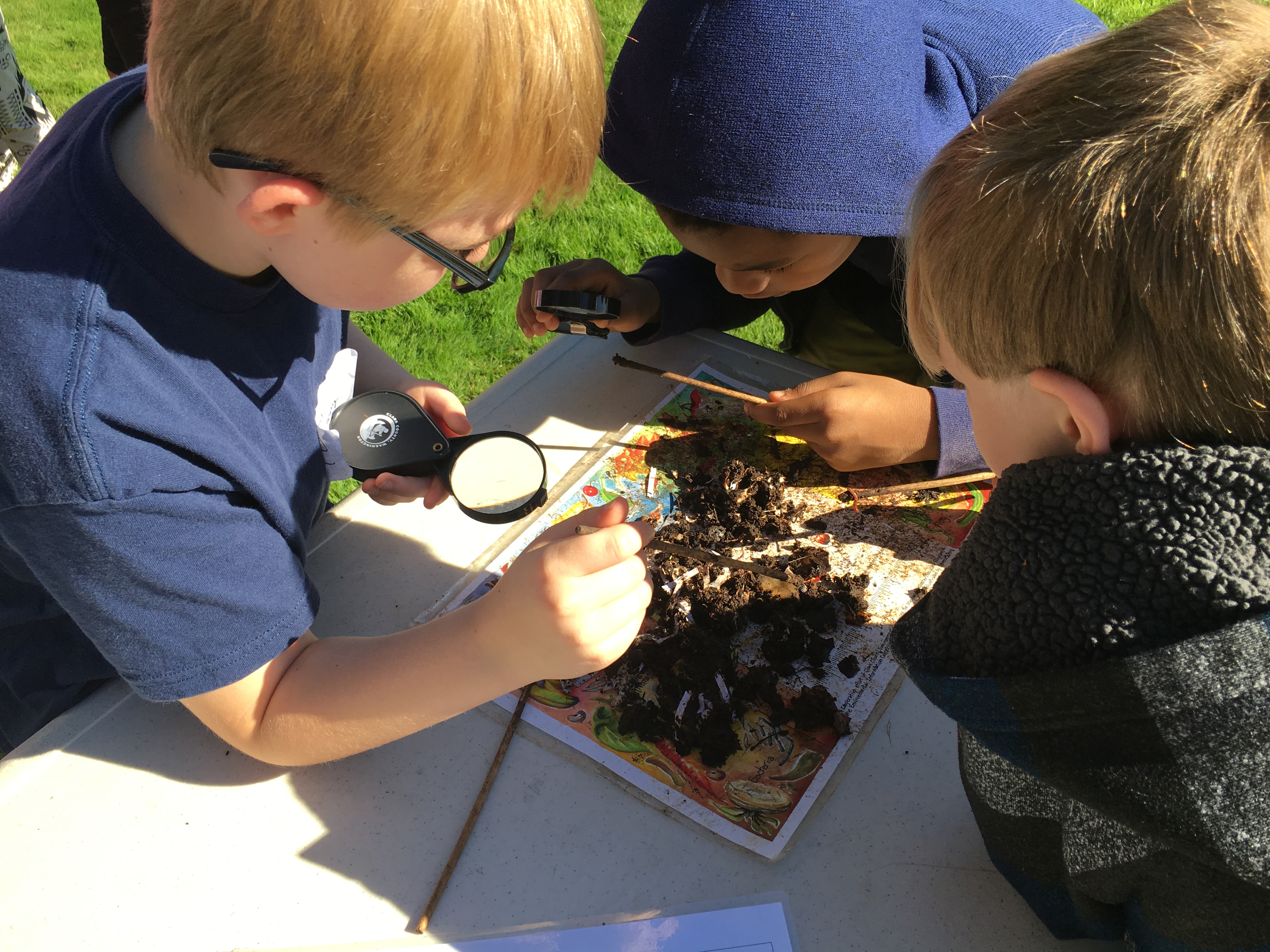
Compost and Decomposers (Gr. 2–3)
Format: interactive presentation, decomposer exploration and identification, modeling and mapping activities
Length: 20–40 minutes
Requirements: none
Topics/subjects: life cycles, relationships between organisms in an ecosystem, environmental stewardship, food production, biology, human impact on ecosystems
Recommended companion lessons: Waste Story, Natural Resources
Summary: Soil is a valuable natural resources that we depend on to produce food, keep our air and water clean, and support ecosystems all over the world. While human populations increase, soil availability and health is decreasing. Composting helps to replenish soil that may have eroded, and returns nutrients to the soil. Students will learn the value of composting and how it benefits our ecosystems and food systems; composting ensures the soil contains the nutrients needed to grow new plants and food. Students will understand how they can play a role in stewardship of the soil through composting. Students will: manipulate a model of the nutrient cycle; compare and contrast recycling and composting; listen to and answer questions about a story read aloud; and make observations about living organisms they find in samples of compost.
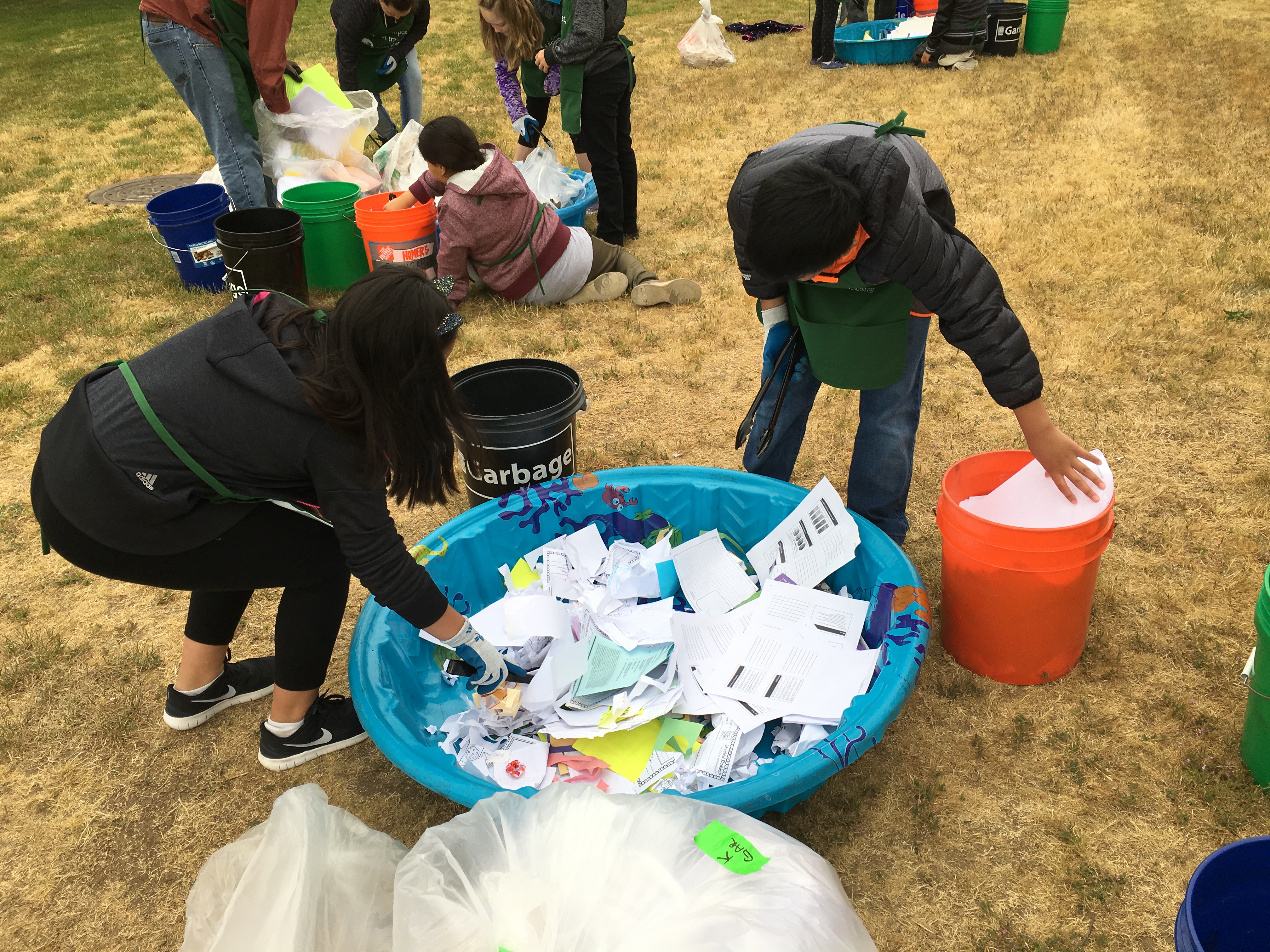
Waste Audit (Gr. 2–6)
Format: project-based learning
Length: 30–40 minutes for presentation/overview, 30–120 minutes for audit
Requirements: collection of school’s waste generated in one day, plan for action-project, preliminary and final audits; it is required that students who will be participating in the Waste Audit receive the Waste Story and Relay before the audit
Topics/subjects: waste reduction; creating social behavior change; data collection, analysis, and application; civic-action projects
Recommended companion lessons: Waste Story (required), West Van Tour, Compost and Decomposers, Plastics in the Water, Natural Resources
Summary: The production of waste has enormous impacts on environments, economies, and societies throughout the world. Each of us has a responsibility to understand the impacts of the waste we produce, how much we produce, and how we can make choices to reduce waste and protect natural resources and human health. Waste audits help students recognize the enormity of solid waste production, disposal, and issues, the impacts fo waste produced at their school/community, and feel empowered to make choices which reduce these impacts. Waste audits involve sorting through the waste produced by the school in one day, and collecting data about the amounts and types of waste (garbage, recycling, compost) generated, and using that data to create a plan for improving waste reduction and disposal at the school.
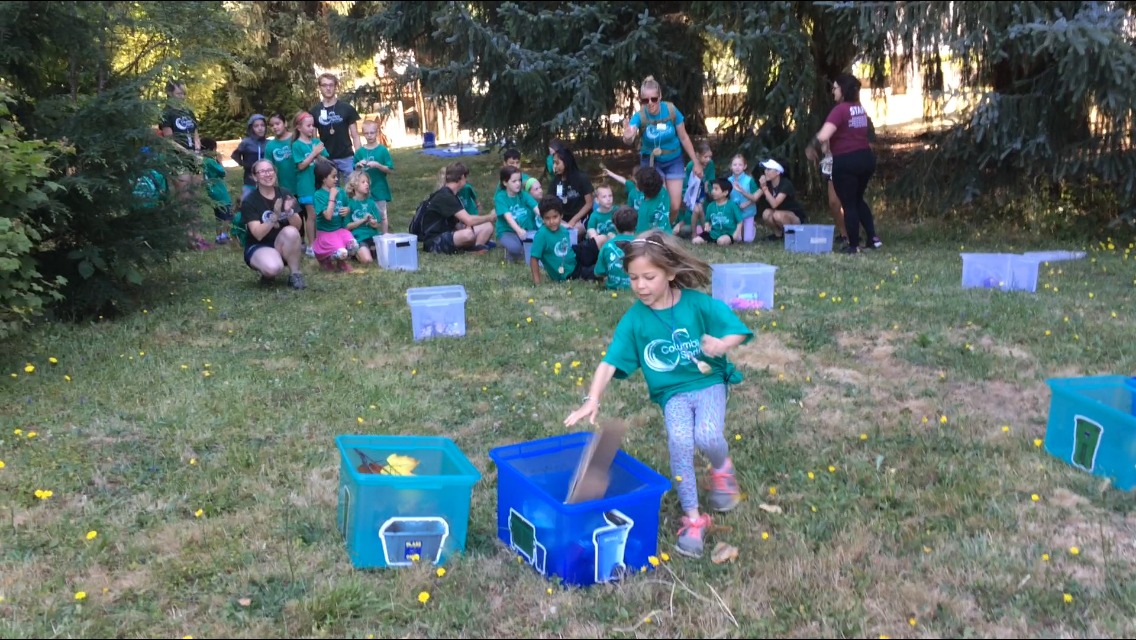
Waste Story and Relay (Gr. 2–6)
Format: presentation and relay-race game
Length: 50–60 minutes
Requirements: space for relay, computer and projector
Recommended companion lessons/activities: Waste Audit, Compost and Decomposers, Natural Resources, Plastics in the Water, West Van Tour
Topics/subjects: “Reduce, Reuse, Recycle,” environmental impacts of waste
Summary: Our society continually produces waste; some of it needs to be disposed of as garbage, while some of it can be recycled or composted. After this lesson and activity, students will understand how waste never “goes away” and has impacts on our environment before, during, and after disposal. The system used locally for sorting the recyclables dictates which items can be recycled. Students will also understand the scale of the massive amounts of fuel, electricity, people-power, and time required for proper waste disposal, including the landfilling of garbage, sort system for recyclables, and commercial composting. Students will also learn about the impacts of improper recycling on the safety of solid waste workers. They will feel empowered to make choices to reduce their impact by reducing waste and recycling right. For the activity portion, students will practice what they learned by working together and racing to sort items into correct disposal categories (reuse, recycle/compost, and garbage). The categories are distanced from the “start” line based on how good (or not) these disposal methods are for humans and for the Earth. Running the relay twice gives students a hands-on opportunity to show what they have learned and to find and correct their own errors.


